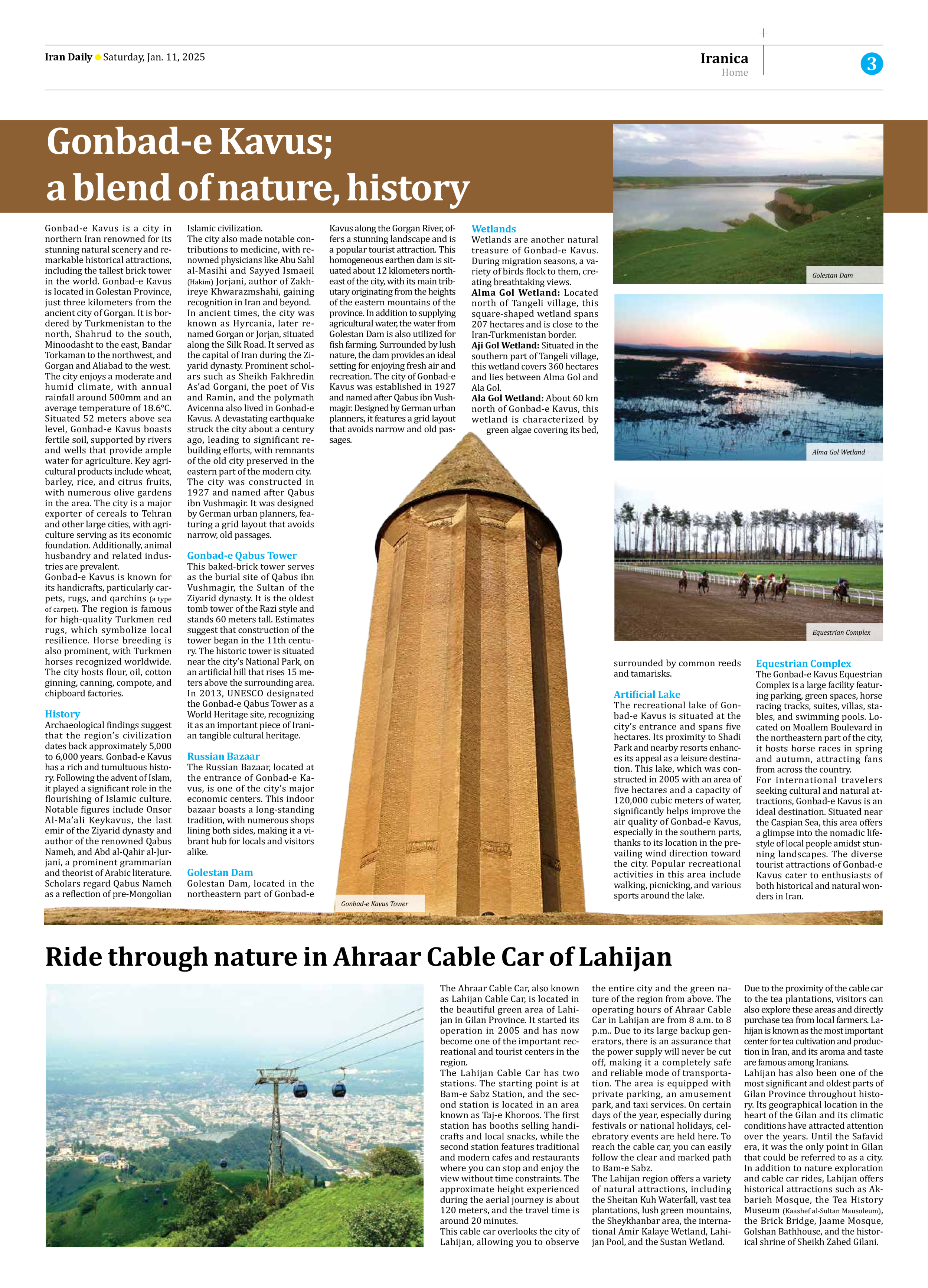
Gonbad-e Kavus; a blend of nature, history
Gonbad-e Kavus is a city in northern Iran renowned for its stunning natural scenery and remarkable historical attractions, including the tallest brick tower in the world. Gonbad-e Kavus is located in Golestan Province, just three kilometers from the ancient city of Gorgan. It is bordered by Turkmenistan to the north, Shahrud to the south, Minoodasht to the east, Bandar Torkaman to the northwest, and Gorgan and Aliabad to the west.
The city enjoys a moderate and humid climate, with annual rainfall around 500mm and an average temperature of 18.6°C. Situated 52 meters above sea level, Gonbad-e Kavus boasts fertile soil, supported by rivers and wells that provide ample water for agriculture. Key agricultural products include wheat, barley, rice, and citrus fruits, with numerous olive gardens in the area. The city is a major exporter of cereals to Tehran and other large cities, with agriculture serving as its economic foundation. Additionally, animal husbandry and related industries are prevalent.
Gonbad-e Kavus is known for its handicrafts, particularly carpets, rugs, and qarchins (a type of carpet). The region is famous for high-quality Turkmen red rugs, which symbolize local resilience. Horse breeding is also prominent, with Turkmen horses recognized worldwide. The city hosts flour, oil, cotton ginning, canning, compote, and chipboard factories.
History
Archaeological findings suggest that the region’s civilization dates back approximately 5,000 to 6,000 years. Gonbad-e Kavus has a rich and tumultuous history. Following the advent of Islam, it played a significant role in the flourishing of Islamic culture. Notable figures include Onsor Al-Ma’ali Keykavus, the last emir of the Ziyarid dynasty and author of the renowned Qabus Nameh, and Abd al-Qahir al-Jurjani, a prominent grammarian and theorist of Arabic literature. Scholars regard Qabus Nameh as a reflection of pre-Mongolian Islamic civilization.
The city also made notable contributions to medicine, with renowned physicians like Abu Sahl al-Masihi and Sayyed Ismaeil (Hakim) Jorjani, author of Zakhireye Khwarazmshahi, gaining recognition in Iran and beyond.
In ancient times, the city was known as Hyrcania, later renamed Gorgan or Jorjan, situated along the Silk Road. It served as the capital of Iran during the Ziyarid dynasty. Prominent scholars such as Sheikh Fakhredin As’ad Gorgani, the poet of Vis and Ramin, and the polymath Avicenna also lived in Gonbad-e Kavus. A devastating earthquake struck the city about a century ago, leading to significant rebuilding efforts, with remnants of the old city preserved in the eastern part of the modern city.
The city was constructed in 1927 and named after Qabus ibn Vushmagir. It was designed by German urban planners, featuring a grid layout that avoids narrow, old passages.
Gonbad-e Qabus Tower
This baked-brick tower serves as the burial site of Qabus ibn Vushmagir, the Sultan of the Ziyarid dynasty. It is the oldest tomb tower of the Razi style and stands 60 meters tall. Estimates suggest that construction of the tower began in the 11th century. The historic tower is situated near the city’s National Park, on an artificial hill that rises 15 meters above the surrounding area. In 2013, UNESCO designated the Gonbad-e Qabus Tower as a World Heritage site, recognizing it as an important piece of Iranian tangible cultural heritage.
Russian Bazaar
The Russian Bazaar, located at the entrance of Gonbad-e Kavus, is one of the city’s major economic centers. This indoor bazaar boasts a long-standing tradition, with numerous shops lining both sides, making it a vibrant hub for locals and visitors alike.
Golestan Dam
Golestan Dam, located in the northeastern part of Gonbad-e Kavus along the Gorgan River, offers a stunning landscape and is a popular tourist attraction. This homogeneous earthen dam is situated about 12 kilometers northeast of the city, with its main tributary originating from the heights of the eastern mountains of the province. In addition to supplying agricultural water, the water from Golestan Dam is also utilized for fish farming. Surrounded by lush nature, the dam provides an ideal setting for enjoying fresh air and recreation. The city of Gonbad-e Kavus was established in 1927 and named after Qabus ibn Vushmagir. Designed by German urban planners, it features a grid layout that avoids narrow and old passages.
Wetlands
Wetlands are another natural treasure of Gonbad-e Kavus. During migration seasons, a variety of birds flock to them, creating breathtaking views.
Alma Gol Wetland: Located north of Tangeli village, this square-shaped wetland spans 207 hectares and is close to the Iran-Turkmenistan border.
Aji Gol Wetland: Situated in the southern part of Tangeli village, this wetland covers 360 hectares and lies between Alma Gol and Ala Gol.
Ala Gol Wetland: About 60 km north of Gonbad-e Kavus, this wetland is characterized by green algae covering its bed, surrounded by common reeds and tamarisks.
Artificial Lake
The recreational lake of Gonbad-e Kavus is situated at the city’s entrance and spans five hectares. Its proximity to Shadi Park and nearby resorts enhances its appeal as a leisure destination. This lake, which was constructed in 2005 with an area of five hectares and a capacity of 120,000 cubic meters of water, significantly helps improve the air quality of Gonbad-e Kavus, especially in the southern parts, thanks to its location in the prevailing wind direction toward the city. Popular recreational activities in this area include walking, picnicking, and various sports around the lake.
Equestrian Complex
The Gonbad-e Kavus Equestrian Complex is a large facility featuring parking, green spaces, horse racing tracks, suites, villas, stables, and swimming pools. Located on Moallem Boulevard in the northeastern part of the city, it hosts horse races in spring and autumn, attracting fans from across the country.
For international travelers seeking cultural and natural attractions, Gonbad-e Kavus is an ideal destination. Situated near the Caspian Sea, this area offers a glimpse into the nomadic lifestyle of local people amidst stunning landscapes. The diverse tourist attractions of Gonbad-e Kavus cater to enthusiasts of both historical and natural wonders in Iran.







